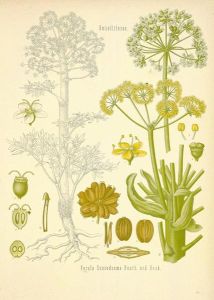Fetid Asafetida
By Audrey Stallsmith

Now there is something to be said for the asafetida bag: the wearer is almost as horrible to others as to himself, and Penrod, equipped with this protection, smelled so that neither germ-bearing persons nor anybody else would willingly come near him, which of course helped to prevent all manner of infection.
Penrod Jashber by Booth Tarkington
Hearing the elderly speak bitterly of asafetida roused my interest in the herb. After all, a plant that has been called both "food of the gods" and "devil's dung" must have an interesting story!
In the "good old days," it was used to treat lung problems like asthma, bronchitis, or whooping cough. The sulfurous asafetida resin was pounded into a paste, placed in a bag, and strung--somewhat like an albatross--around the sufferer's neck. This apparently worked so well that some mothers got the bright idea of making their offspring wear the malodorous stuff all winter to prevent additional problems. An amulet of sorts, one might say.
The herb does contain antiviral compounds, but I'm not sure how much good just wearing it would do! When used to improve digestion asafetida is often smeared on the stomach, however, so it's possible that its effects can be absorbed through the skin.
Or, as Tarkington suggests, it might have only worked by keeping contagious people--and everybody else!--at a distance. But back in the days when viruses were more likely to be fatal, mothers probably weren't too picky about why asafetida worked, as long as it did.
Since the herb, otherwise known as Ferula foetida or assafoetida, grows wild in Afghanistan, Iraq, and India, it is not a very cold-hardy plant. So I'm guessing that most of the resin that once afflicted U. S. school children was imported. That resin is obtained in summer by slashing the plant's carrot-like roots and allowing what oozes out to dry.
Asafetida gets its name from asa (Persian for "resin") and foetida (Latin for "stinky!"). Ferula means "carrier," as ancients sometimes used the plant's hollow stems to transport hot coals from camp to camp. The word "ferule," in reference to a stick for punishing children, may actually derive from the plant's name--as "giant fennel" grows to seven feet and produces long rods. Yet another reason for it to be unpopular with kids!
It will reportedly repel pests from the garden as well, though it is not disliked by all species. It has actually been used to bait wolves, fish, and moths.
They can probably smell it from a distance since, as Mrs. Grieve writes tactfully in A Modern Herbal, asafetida's odor is "stronger and more tenacious than that of the onion." Fortunately, the sulfur is dispelled somewhat by cooking, leaving the herb smelling--and tasting--more like a combination of onion and garlic. So it is actually quite popular in Indian cuisine, Iranians rub it on the plates on which meat is to be served, and it is supposed to be the "secret" ingredient in Worcestershire sauce. Because it can prevent or relieve intestinal gas, asafetida is often used to flavor beans.
In ancient times, asafetida sometimes served as a substitute for silphium, another ferula which grew near Cyrene in what is now northeast Libya, and eventually went extinct. An unfortunate loss, as silphium reportedly boasted a superior taste and fragrance. Dioscorides wrote that "the Cyrenaic kind. . .has a very healthy aroma, so that it is not noticed on the breath, or only a little." And might have spared a couple generations of kids a lot of misery!
In addition to the resin, which is harvested by slashing the roots, asafetida also produces umbels of yellow-green flowers and cabbage-like heads. The "cabbages" are eaten raw and the young shoots of the plants sometimes cooked like asparagus.
In addition to preventing disease and treating respiratory problems and indigestion, asafetida is also a stimulant and laxative. And James Duke recommends it as a possible treatment for irritable bowel syndrome. So we can't entirely discount the old-fashioned idea that the more unpleasant medicines are the better they work!
Ferula assafoetida (aka scorodosma) image is courtesy of Botanical.com.








